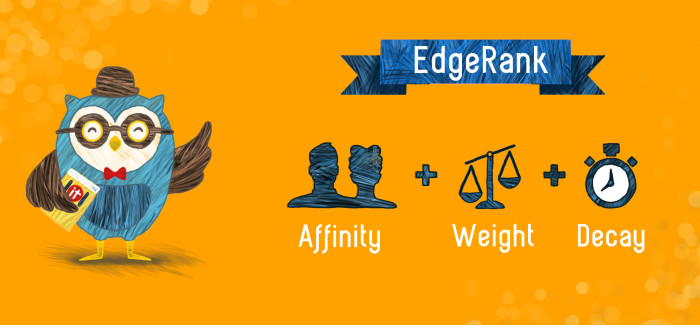Let’s talk about EdgeRank

- CEO
- On February 18, 2015
- http://www.101itconsult.com
Have you ever wondered how it’s decided what posts feature in your News Feed? How does Facebook know what we prefer and who we like?
40% of the time we spend on Facebook is on News Feed and we should learn how it works. There’s an algorithm that decides what posts come up on our Timeline. It’s like maths, but cooler. First of all, let’s make things clear: News Feed is the center column that appears after you click Home – a constantly updated list of posts of people and pages that you follow on Facebook. EdgeRank is the Facebook algorithm to determine where and what articles are appearing on a user’s own News Feed.
There are 3 components for the algorithm:
- Affinity
- Weight
- Time Decay
Affinity
Affinity calculates the relation between the user that sees the post in News Feed and the person that made the post. The closer the relationship, the higher the affinity is. Therefore, it’s very likely that you see in your News Feed posts of your close friends, than of relatively unknown people which whom you haven’t interacted. You may have observed that once you communicate with a certain user on Facebook, his/her posts start to appear more frequently on your News Feed.
“Social media takes time and careful, strategic thought. It doesn’t happen by accident.” – Brian E. Boyd Sr
Affinity works the same also for pages – you see in News Feed posts of pages you have already interacted with in the past. The higher your engagement with a page (likes, clicks, comments, and shares), the higher the chance their posts feature on your News Feed. It works the same with the page’s photos – if you reacted more to this type of share (likes, comments), you’ll see more photos. On the other hand, if a post has negative feedback already, it’s unlikely that you’ll see it.
Weight
Weight is a value system created by Facebook to increase/lower the value of a certain type of actions on Facebook. Comments require a higher degree of engagement and, therefore, are considered more valuable than, for example, a like. Consider the following: you will see more posts of a page where you usually comment, than posts of another one where you commonly just click like. The most “valuable” posts are photos and videos, followed by links and simple text.
Time Decay
Time Decay is the simplest notion to explain. The older a post is, the more it loses its value and visibility. News Feed needs to be always fresh. The good thing is your posts have increased chances to reach to people actually interested in the subject you share – engagement rises. Moreover, “high quality” posts are visible to more people, whereas the ones that receive negative feedback are “sanctioned”. And, not the last, you see personalized posts, just for you.
The other side of the coin is that Facebook forgets about passive users, which stop receiving in News Feed posts appealing to them. A page’s posts are less seen in fans’ News Feed without promotion, resulting in a post visibility of some 15%. This leads to more money spent by pages on advertising to reach its fans.
If some time ago, things were simpler, this new EdgeRank feature makes companies fight for a little space in everyone’s News Feed, to strive for engagement and spend money on Promoted Posts. Understanding how EdgeRank works is a must for every page manager that wants to reach fans more effectively.

Submit a Comment